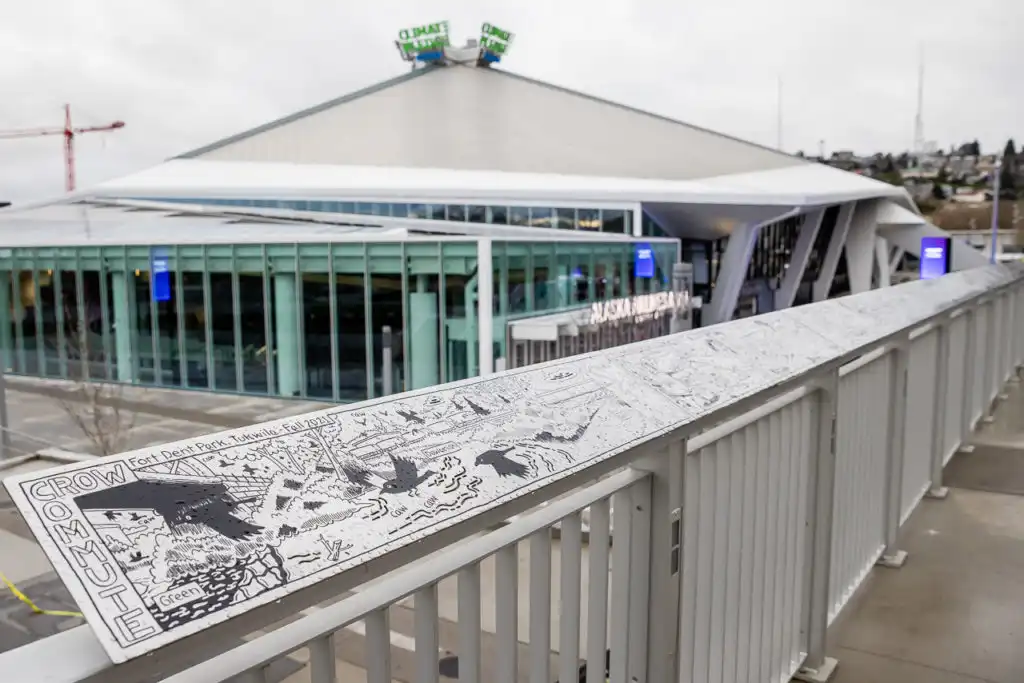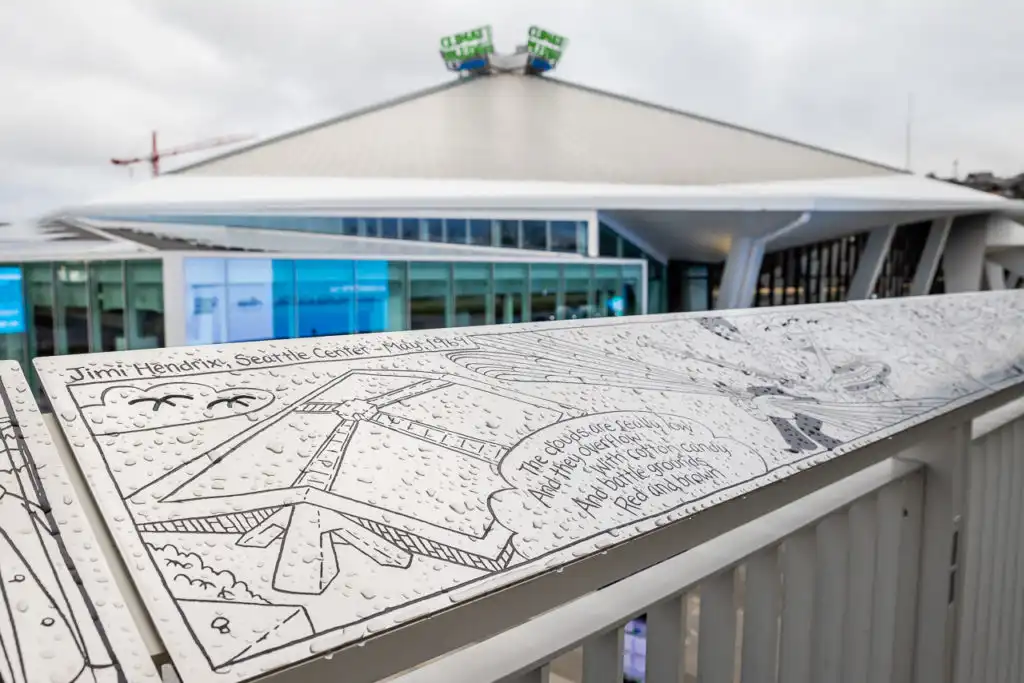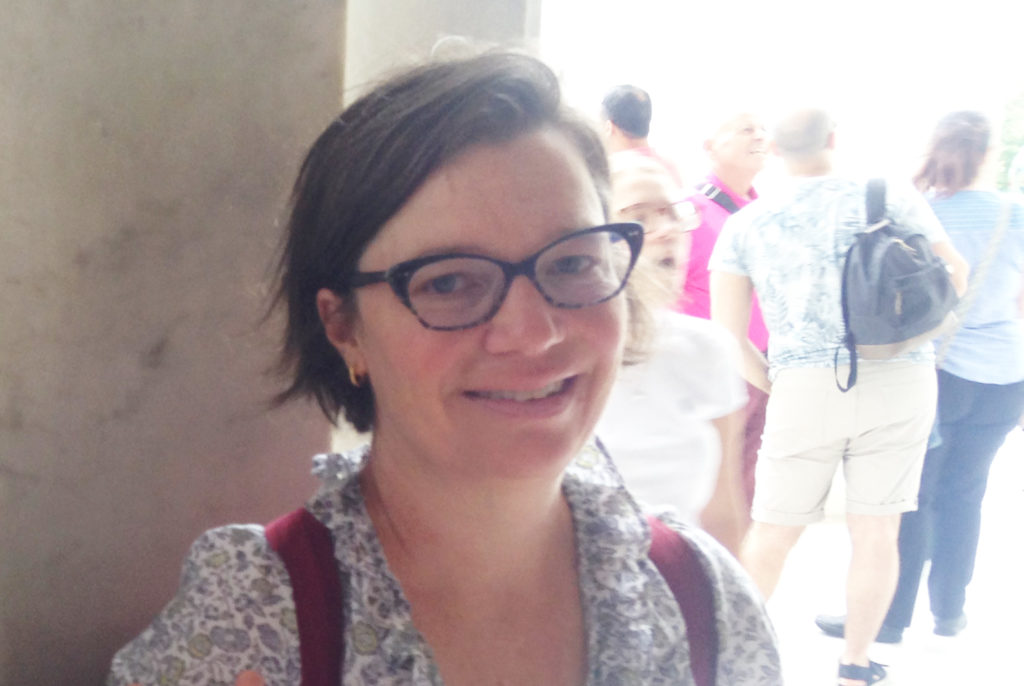By Megan Kelso
“Crow Commute” is a long mural of etched stainless steel panels that will add up to a portrait of the city that will work as both a timeline and a map. There will be 21 panels (10 inches high X 4 feet long) for 85 feet that span Seattle history from 1969 to today.



Arena Project: Memory Rail “Crow Commute”
Megan Kelso (born 1968 in Seattle, Washington) is an American comic book artist and writer who lives with her husband and daughter in Seattle, Washington.
I graduated from Garfield High School in the late 80’s. I went to Folklife and Bumbershoot regularly as a teenager. I saw the band X play Bumbershoot in Paul Thiry’s arena that used to be called the Coliseum. I attended a protest against the Iran/Contra scandal there in 1987 and saw the Sonics play there – it was Key Arena by then. In 1994, after Kurt Cobain killed himself, I went to the wake fans held for him at the International Fountain. Years later, I took my daughter to play in that fountain. I volunteered for the free health clinic at Key Arena in 2016 and 2017. This place: Seattle, the Seattle Center, the Coliseum, Key Arena, the New Arena – is inside of me.
I began making comics in the 1990s when I was a college student at Evergreen in Olympia, Washington. In the late eighties, there was an explosion of creativity in the Pacific Northwest that evolved into the Grunge and Riot grrl movements. What was new was that women, gays and gender non-binary people took possession of Punk, infusing it with a practical sweetness and an optimistic disregard for expertise. My comic book was called “Girlhero” and I made 50 copies on a photocopier, in the manner of the punk ‘zines I saw other people making. I taught myself to draw comics by looking at comics, and later found mentors among my contemporaries. I have since published several other projects including “Queen of the Black Black” and “The Squirrel Mother.” I was the editor of the female cartoonist anthology, “Scherherazade: Stories of Love, Treachery, Mothers, and Monsters” (published by Soft Skull Press). I have also also created work for several magazines, including the now-defunct Tower Records‘ Pulse Magazine. In 2007, I published a weekly comic strip in The New York Times Magazine titled “Watergate Sue.” I have published three books (one graphic novel and two short story collections), published by Fantagraphics Books, and a fourth book in process.
I have a talent for telling stories and an ability to wield visual and literary metaphors. My first comics were about female transgression: a girl factory worker does surgery on her own arm, making it into a gun that helps her girlfriends fight back against an abusive boss. With age, my themes broadened; I examined parent child relationships, American history, abuse of power, and motherhood. Place has always been my muse. I am besotted by the landscapes and cityscapes of the Pacific Northwest. If I know where a character is from, I can find my way into their story. What sets me apart from many of my cartoonist contemporaries is that I’ve always worked in the fictional realm. Beginning with the grounding of place and history, my stories have always had some magic around the edges.
I design sculptures to seek the very essence, the simplicity of a concentrated energy. My ideas speak the language of shape. Three dimensional art engages us, as nature does, on a fundamental level. There is a place in us that is touched by the power of forms. I want my works to uplift the spirit as a graceful gesture, to inspire feelings of happiness and timelessness. As a (Sansei) Japanese American, my designs are a confluence of the cultures and traditions of the Pacific Rim. Growing up with a heritage of Japanese design and in the Pacific Northwest’s beautiful natural environment has instilled a humanistic spirit to my sculptures. I may be inspired by a Tongan war club or the folds of origami paper. These elements and feelings are subliminally integrated into my art.
I began in 1971 working as an apprentice learning to fabricate large bronze fountains and sculptures. My early career included explorations of abstract expressionism, with its freedom of design and a tempered sense of balance. My first public art commission was in 1978, a dragon for the International District Children’s Park. In 1999 I created the iconic “MITT” sculpture blending both whimsy and baseball history for the Seattle Mariners Stadium. These sculptures are approachable and interactive, a theme that has become a basis for many of my public sculpture designs. My 48 years of studying and creating art have taught me to believe in myself. My knowledge has come from the wealth of experiences and challenges of each new project. Throughout my career, I’ve taken the chance to make even the littlest idea work into a new sculpture.
Do you want to know when tickets drop?
Sign up for our mailing list and stay in the loop.
Site by usheru
Do you want to know when tickets drop?
Sign up for our mailing list and stay in the loop.